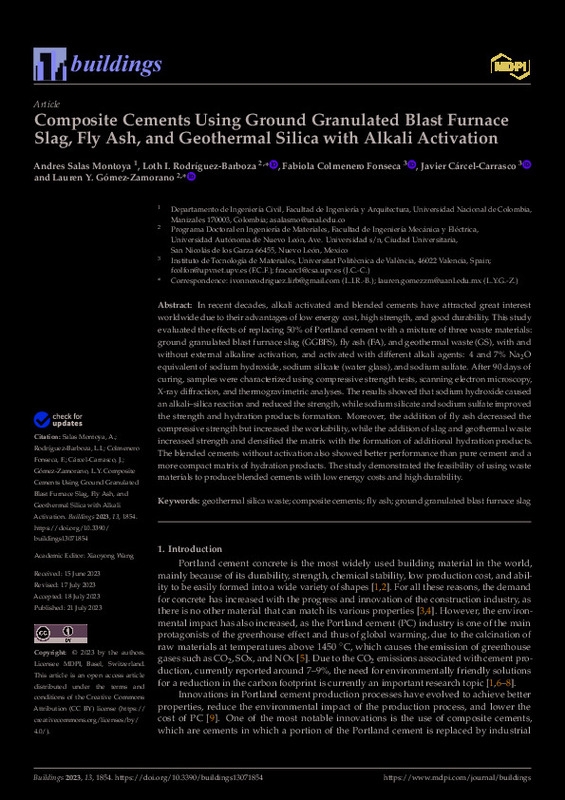JavaScript is disabled for your browser. Some features of this site may not work without it.
Buscar en RiuNet
Listar
Mi cuenta
Estadísticas
Ayuda RiuNet
Admin. UPV
Composite Cements Using Ground Granulated Blast Furnace Slag, Fly Ash, and Geothermal Silica with Alkali Activation
Mostrar el registro sencillo del ítem
Ficheros en el ítem
| dc.contributor.author | Salas Montoya, Andres
|
es_ES |
| dc.contributor.author | Rodríguez-Barboza, Loth I.
|
es_ES |
| dc.contributor.author | Colmenero-Fonseca, Fabiola
|
es_ES |
| dc.contributor.author | Cárcel-Carrasco, Javier
|
es_ES |
| dc.contributor.author | Gómez-Zamorano, Lauren Y.
|
es_ES |
| dc.date.accessioned | 2024-04-25T10:27:50Z | |
| dc.date.available | 2024-04-25T10:27:50Z | |
| dc.date.issued | 2023-07 | es_ES |
| dc.identifier.issn | 2075-5309 | es_ES |
| dc.identifier.uri | http://hdl.handle.net/10251/203744 | |
| dc.description.abstract | [EN] In recent decades, alkali activated and blended cements have attracted great interest worldwide due to their advantages of low energy cost, high strength, and good durability. This study evaluated the effects of replacing 50% of Portland cement with a mixture of three waste materials: ground granulated blast furnace slag (GGBFS), fly ash (FA), and geothermal waste (GS), with and without external alkaline activation, and activated with different alkali agents: 4 and 7% Na2O equivalent of sodium hydroxide, sodium silicate (water glass), and sodium sulfate. After 90 days of curing, samples were characterized using compressive strength tests, scanning electron microscopy, X-ray diffraction, and thermogravimetric analyses. The results showed that sodium hydroxide caused an alkali-silica reaction and reduced the strength, while sodium silicate and sodium sulfate improved the strength and hydration products formation. Moreover, the addition of fly ash decreased the compressive strength but increased the workability, while the addition of slag and geothermal waste increased strength and densified the matrix with the formation of additional hydration products. The blended cements without activation also showed better performance than pure cement and a more compact matrix of hydration products. The study demonstrated the feasibility of using waste materials to produce blended cements with low energy costs and high durability. | es_ES |
| dc.description.sponsorship | This research was funded by CONAHCYT (National Council of Humanities, Science and Technology, Consejo Nacional de Humanidades, Ciencia y Tecnología México) and UANL (PAICYT). This research was conducted at FIME-UANL, the authors acknowledge the support that has made the laboratory and the operation possible; to Universidad Nacional de Colombia, and María Zambrano (UPV, Ministry of Universities, Recovery, Transformation, and Resilience Plan Funded by the European Union Next Generation EU) of the Institute of Materials Technology of the Polytechnic University of Valencia (Spain); and UPV s Aid to Promote Postdoctoral Research (PAIDPD-22). | es_ES |
| dc.language | Inglés | es_ES |
| dc.publisher | MDPI AG | es_ES |
| dc.relation.ispartof | Buildings | es_ES |
| dc.rights | Reconocimiento (by) | es_ES |
| dc.subject | Geothermal silica waste | es_ES |
| dc.subject | Composite cements | es_ES |
| dc.subject | Fly ash | es_ES |
| dc.subject | Ground granulated blast furnace slag | es_ES |
| dc.subject.classification | CONSTRUCCIONES ARQUITECTONICAS | es_ES |
| dc.title | Composite Cements Using Ground Granulated Blast Furnace Slag, Fly Ash, and Geothermal Silica with Alkali Activation | es_ES |
| dc.type | Artículo | es_ES |
| dc.identifier.doi | 10.3390/buildings13071854 | es_ES |
| dc.relation.projectID | info:eu-repo/grantAgreement/UPV//PAIDPD-22/ | es_ES |
| dc.rights.accessRights | Abierto | es_ES |
| dc.contributor.affiliation | Universitat Politècnica de València. Escuela Técnica Superior de Gestión en la Edificación - Escola Tècnica Superior de Gestió en l'Edificació | es_ES |
| dc.description.bibliographicCitation | Salas Montoya, A.; Rodríguez-Barboza, LI.; Colmenero-Fonseca, F.; Cárcel-Carrasco, J.; Gómez-Zamorano, LY. (2023). Composite Cements Using Ground Granulated Blast Furnace Slag, Fly Ash, and Geothermal Silica with Alkali Activation. Buildings. 13(7). https://doi.org/10.3390/buildings13071854 | es_ES |
| dc.description.accrualMethod | S | es_ES |
| dc.relation.publisherversion | https://doi.org/10.3390/buildings13071854 | es_ES |
| dc.type.version | info:eu-repo/semantics/publishedVersion | es_ES |
| dc.description.volume | 13 | es_ES |
| dc.description.issue | 7 | es_ES |
| dc.relation.pasarela | S\497546 | es_ES |
| dc.contributor.funder | European Commission | es_ES |
| dc.contributor.funder | Universidad Autónoma de Nuevo León | es_ES |
| dc.contributor.funder | Universitat Politècnica de València | es_ES |
| dc.contributor.funder | Consejo Nacional de Humanidades, Ciencias y Tecnologías, México | es_ES |








